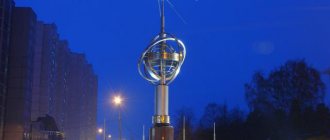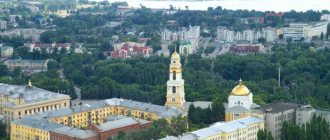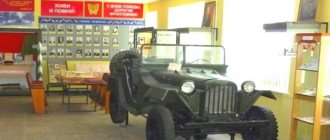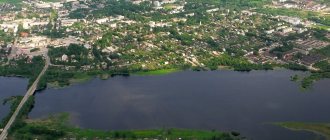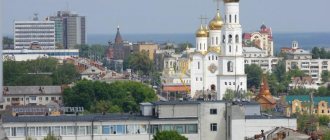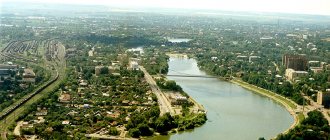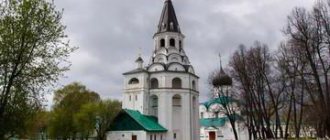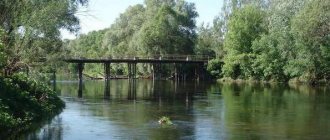- September 11, 2019
- Directions
- Molton
Kursk is one of the largest Russian cities. Where is Kursk? The city is located in the west of the European territory of Russia, 519 km from the Russian capital. This is one of the westernmost cities in the country. Kursk has a long history. It has been mentioned as a city since 1095. Now it is an important scientific, cultural, religious, educational, industrial and transport center.
The area of the city is 208 km2, and the height above sea level is 250 meters. Number of inhabitants: 448,733 people. The mayor of the city is V.N. Karamyshev.
Geography of Kursk
Many people are interested in the question: where is Kursk located, in what region? The city is located on a plain in the west of European Russia. This is the administrative center of the Kursk region. Time zone is Moscow. The climate in the city is largely determined by where Kursk is located. It is temperate continental, with an average January temperature of -6.2 °C, and July of +19.8 °C. This means that winters are relatively mild and summers are neither hot nor cold. The amount of precipitation is significant - 648 mm per year. The maximum occurs in June and July (71 and 78 mm, respectively). In the last decade, summers have become noticeably warmer, and annual temperatures have increased slightly. The amount of precipitation decreased slightly.kur
Stories, routes and tips from tourists with photos
A list of attractions that are worth seeing in Kursk in 1 day can be found in traveler reviews. Tourists share their impressions of the city and give advice on how to have an enjoyable time in Kursk. You can use someone’s ready-made route, or you can create your own based on the recommendations of other tourists. In tourist reports about Kursk you will find photographs of the city at different times of the year, as well as tips on where to eat and where to spend the night.
- The story “Meet Kursk!” (Vladimir)
- Photo album “Kursk” (Igor Butyrskii)
- The story “The image of the Virgin Mary found in the roots of a tree. Kursk Root Hermitage" (NatalyA)
All tourist reviews about Kursk on Turister.ru
Photo: © Igor Butyrskii
Urban transport
Public transport in Kursk is quite diverse. There are buses, trolleybuses, trams and even electric buses running around the city. Transport of smaller capacity is represented by minibuses. During the year, urban transport transports up to 200 million people. Kursk trolleybuses have free Internet access.
The vast majority of city routes are bus routes. There are 125 of them. At the same time, there are only 5 tram routes, and 8 trolleybus routes. Gradually, minibuses are being replaced by larger units of transport equipment.
Archive number No. 9 (1272) dated February 26, 2021 - News
LOCAL HISTORY
The regional center has completed accepting applications for the open architectural competition “Kursk 2032” to create a concept for restoring the historical and cultural appearance of the central part of the city. The regional administration reported that 74 applications were received. Later we will introduce them to DDD readers. Now participants have until March 30 to send completed projects. In the meantime, we will remember what the historical part of Kursk looked like in different years. And let's start with the so-called “detinets”, or fortress limited by the territory.
Office buildings
Two buildings on the corner of Sonina Street at the turn to Red Square. The first brick office building in Kursk was built near the monastery in 1793. The 2-story government building, roofed with iron, stretched from the Pyatnitskaya Church (now the site of the Znamensky Cathedral) to the sharp turn of the current Sonin Street. Towards the cliff near the Tuskari River, it had a height of three floors along the slope. On the top there were: the provincial government, the treasury, civil and criminal chambers, the prosecutor's office, the order of public charity, on the bottom - the recruiting presence, the treasury, the drinking collection department, the court, archives, the first printing house in Kursk. On the ground floor along the slope there was a guardhouse, a cash storeroom and liquor stores.
Large windows looked impressively from the austere facades at the governor-general's house located opposite, the vast governor's garden, where now the attractions in the May 1st Park are located, and Streletskaya Sloboda. The central entrance was decorated with a group of columns supporting a hemispherical dome.
The construction site, which belonged to the monastery, was transferred in 1779 by the governor, Lieutenant General P. S. Svistunov. He wrote: “Due to the dilapidation of the buildings in the monastery, it is inevitable to break down part of the fence of the mentioned monastery, located on the roadway, as well as the Corner Tower in this fence, since they are very prone to falling due to dilapidation; the tower was cracked, and the fence onto the street was leaning.”
At the beginning of the 20th century, the provincial government office with departments: construction, medical, veterinary, land surveying, archives, guardianship of the correctional and prison departments, treasury and the treasury chamber was located in the public office building. In 1903, the premises were occupied by the historical, archaeological and handicraft museums (now the local history museum), and the county police department.
After the revolution, the provincial economic council was located here. During the Civil War, the building was damaged by fire. In 1930, a city council project was approved to restore the building for a nine-year school, but the Second Higher Communist Agricultural School was located there.
The building was destroyed during the Great Patriotic War; in the late 1950s, a factory workshop was built on the ruins.
The second building of public places, called special, began to be built in 1888 next to the first building. It housed the provincial statistical committee, the apartment of the vice-governor, the notary office, the prosecutor's office and the district court. In front of the building at the beginning of the 20th century, two paths of a “liquid” boulevard stretched from Red Square along the current Sonina Street down to the parish school.
After the revolution, the building housed the provincial department of justice, the revolutionary tribunal, the provincial economic council, then the office of the provincial court and the office of the chairman, the investigative unit, and later the services of the provincial prosecutor's office. In 1928, due to the creation of the Central Black Earth Region and the liquidation of the Kursk province, all city court bodies and the prosecutor's office, as well as the people's court, the duty chamber, bailiffs, the notary's office and the central college of defenders were transferred here.
After the organization of the Kursk region in 1934, the regional court services returned to the building, and at the very beginning of the war, the wards of rear hospital No. 1091 were deployed in it. The three-story building was heavily damaged. The surviving brick box was restored in the early 1950s for the repair shop of the electrical equipment plant. The inside of the building has undergone a major renovation.
Monastery Tower
The Central State Military Historical Archive in Moscow houses a very rare document - the so-called “Outline of the City of Kursk” from 1722. In 1597, Tsar Fyodor Ioannovich issued a decree on the restoration of the fortress in Kursk. Built again in the 1st half of the 17th century, it withstood three sieges of the Poles, fought off attacks by the Crimean Tatars four times, and was never surrendered to the enemy.
...At the sharp turn of Sonina Street near the park named after May 1, there once stood a tall log Red Tower, along the cliff from it a 4-meter-high tyn (logs dug vertically into the ground) ran to the west. Below was the passage Tuskarnaya Tower, and next to it along the fortress wall there was a long building with artillery equipment.
Closer to the confluence of the Kur and Tuskar rivers there was an exit tower with a gate, and next to it was a forge. Tyn ended with a formidable bastion - an artificially raised rampart of white marl. From there the fortress wall went north to the Nikitskaya Tower, next to which there was a prison. The northern wall of the triangle of the Kursk fortress connected the Nikitskaya and Red towers; in the middle stood the elegant Pyatnitskaya Tower with the entrance gate (opposite what is now Lenin Street). Between the Red and Pyatnitskaya towers were crowded a storehouse (warehouse), a two-story bishop's house, a cathedral bell tower and a guardhouse.
Behind the fortress wall stood the powerful walls of the monastery in a quadrangle, topped at the corners of the fence with hipped roofs on the towers. The round brick tower with a dome and part of the adjacent wall are the stone remains of the former monastery fence, the first information about the construction of which is known from the letter of Tsar Alexei Mikhailovich, father of Peter I, sent to Prince I.M. Volkonsky in Kursk in 1656.
By 1779, the stone walls of the monastery fence had become dilapidated and required repairs, and the northern wall, which ran along the current Pervomaisky Park, was leaning... Today, from the walls of the monastery fence there remains a miraculously preserved tower, facing Sonina Street - this is a historical monument.
A written source of the 17th century - an inventory of the Kursk fort of 1651 - mentions a secret well hidden below the fortress wall and leading towards Tuskari. This underground passage has been described, but no one has seen it yet. The existence of the “passage” was confirmed by research by geophysicists, who, using special instruments, discovered voids under Sonin Street.
And local historian Viktor Kryukov, our colleague from the Gorodskie Izvestia newspaper, having visited the tower, noted that at the base from the side of the monastery it was covered with earth for about three meters: “The 1st floor has an earthen floor made of compacted construction waste with a careless cement screed on top . It cracked and noticeably sank towards the center, revealing some local failures. Judging by the plumes of sand,... during rainstorms and spring floods, the water freely goes down somewhere. Where?"
House of Officers
The Noble Assembly is a three-story brick building in the eclectic style at the intersection of Sonin (formerly Verkhne-Naberezhnaya) and Endovishchenskaya streets, an architectural monument of federal significance.
Built in 1877 for the Assembly of the Nobility, the building was seriously damaged in fires and underwent a number of significant reconstructions, although the brick facades were not affected. Over the years, the Noble Assembly, the Workers' Palace, the Revolutionary Military Council of the Southern Front, an art museum, the Railwaymen's Club, the House of the Red Army, and the garrison House of Officers were located here. Now the building has been transferred to the balance of the Kursk Regional Philharmonic to house a second concert venue.
At the end of the 18th century, the building of the Noble Assembly with an adjacent theater, built in 1792, was located on this site. In 1805, Mikhail Shchepkin, a 17-year-old serf of Count Wolkenstein, later a great actor, made his debut there. On the night of December 30, 1875, a fire started in the theater due to the fault of a drunken role copyist. The unprofessional actions of the firefighters led to the loss of the Noble Assembly; it burned to the ground.
In 1877, a new brick building of the Nobility Assembly was built. On the afternoon of October 17 (29), 1892, for an unknown reason, a fire broke out and quickly spread. By the morning of October 18, all the ceilings had collapsed, leaving only bare walls.
The building was restored again at the beginning of the 20th century. The Great Hall hosted meetings of nobles, balls, concerts or theatrical performances: Fyodor Chaliapin and Nadezhda Plevitskaya performed here.
In 1918, the building was renamed the Workers' Palace. It housed trade union organizations, organized rallies, congresses, and holidays for the proletariat. In September 1919, when Kursk was in the hands of the White Guard, it set up its headquarters in the building; in January-February 1920, it already housed the headquarters and the Revolutionary Military Council of the Southern Front, one of whose members was Joseph Stalin.
On September 12, 1920, an art museum was opened in the Workers' Palace; in 1922, it housed the provincial labor department, social security, and a proletarian club; later the building was given to the Railway Workers' Club. On November 12, 1929, the House of the Red Army was opened here, where ceremonial meetings were held, a cinema functioned, invited artists performed, sports competitions were organized, and the Stalin Museum operated.
In February 1943, during the retreat from Kursk, the Nazis set fire to the building. It lay in ruins for a long time. In the early 1960s, the building was restored with funds from the USSR Ministry of Defense, while the appearance of the Assembly of the Nobility was completely preserved, and significant reconstruction was carried out inside. The garrison House of Officers was located here, which became an important cultural center of the city.
Men's gymnasium – “house with a spire” –
was once the longest building in old Kursk. Facing the front facade to the west, it rises majestically on the historical hill where the fortress was located, making a strong impression with its scale.
The first public school building was built in 1794 using private donations. In 1801–1802, the future great actor Mikhail Shchepkin studied there. Since 1808, the provincial men's gymnasium has been located here. On May 14, 1836, the tsar approved the design of the new gymnasium building, and on August 23, the foundation stone for a new building adjacent to the old building took place. The builders quickly laid the foundation and built the walls to a great height, but on the night of October 4, 1836, a fire destroyed the old gymnasium, leaving only the walls.
As a result, a new 3-story building built on a high hill seemed to block the most beautiful view of the historical center of the city from the west: at the top of the hill stood the bulk of the Znamensky Cathedral, below was the bishop’s house with a beautiful portico (now a local history museum).
While passing through Kursk in 1842, Emperor Nicholas I inspected the new gymnasium and was pleased. After the revolution of 1917, several schools, provincial public education services, a House of Physical Education and service apartments were located here. The future composer Georgy Sviridov studied at secondary school No. 4; in March 1926, People's Commissar of Education Lunacharsky met with teachers of the city. In the early 1930s, an artillery unit was located in the building.
During the Great Patriotic War it was destroyed and burned by the German invaders. During restoration in 1950, a 4th floor was added. At the same time, on the extension adjacent to the main building, a tower with a high sharp spire topped with a weather vane was erected... The building housed the workshops of an electrical equipment plant.
Three more ancient buildings on the territory of the Kursk “detinets” are the well-known Znamensky Cathedral, built in 1815–1826, and the Resurrection Church, built in 1875, as well as the building of the local history museum - the house of the bishop. We will talk about them in the next issue of DDD.
There are many legends associated with the Znamensky Cathedral, which during the years of Soviet power was turned into the Oktyabr cinema. During its construction, part of the old foundation was used; in the cold season, the building was heated by huge stoves located in the basement - the semi-basement part of the cathedral building. The monks most likely stored the supply of firewood in the dungeon, but on the floor below the stoves themselves - on the “minus second” floor. It was from there that part of those legendary underground communications of Kursk could begin.
Read in the issue dated March 5, “New mysteries of the Kursk dungeons.”
To be continued
Stepan KOROLYOV
Share link:
Subscribe to “For Each Other”:
Yandex News Yandex Zen Google News YouTube Video
Reviews about Kursk
People are not very active in writing reviews about this city. Many speak negatively about the character of the local residents, considering this the main disadvantage of Kursk. There is also an insufficient number of parks and a reduction in green spaces. They write about salaries that they are low, there is a problem of unemployment, lack of rights for workers. The economic situation is said to be unfavorable. They write that without connections it is difficult to get a decent job, and that life is much better in other cities.
The advantages include good opportunities for growing crops and a large number of retail outlets. They also note that in general this city is no worse than other Russian cities.
Of course, reviews reflect the personal experiences of the authors and do not guarantee that others will necessarily encounter the same problems.
Princely times
Kursk became the center of an appanage principality until 1095, when Vladimir Monomakh, at that time the Prince of Chernigov, and later the Great of Kiev, appointed his son Izyaslav Vladimirovich to reign in this city. But already in 1095, Izyaslav, by order of his father, retired to rule in Murom. In 1096, the prince died in one of the internecine battles. Despite his short reign, Izyaslav managed to build a fortress in Kursk.
The history of the city of Kursk for children is most interesting when it comes to Prince Vsevolod Svyatoslavovich, nicknamed Bui-tur. He is one of the main characters in The Tale of Igor's Campaign. This prince became famous for his incredible strength and courage. Even before his reign, Kursk turned into one of the main fortress borders, designed to protect Rus' from raids by the Polovtsians and other nomads.
In 1180, Vsevolod became Prince of Kursk and Trubetskoy. During his reign, he became famous for his participation in numerous campaigns together with other princes against the Polovtsians. The most famous is the campaign of 1185, sung in the “Tale of Igor’s Campaign,” when he, together with his brother Igor Svyatoslavovich, Prince of Novgorod-Seversky, was captured by the Polovtsians. Vsevolod returned from captivity only in 1188. In 1196 he died.
Taking part in the infamous Battle of Kalka against the Mongols in 1223, the inhabitants of Kursk also sent their garrison to the Russian army. In 1238, during Batu's invasion, the city was destroyed by the Mongol-Tatars. After this, Kursk was rebuilt, but was again devastated in 1285.
In 1362, the Grand Duke of Lithuania Olgerd managed to wrest the city from under Tatar rule and annexed it to his lands.
The symbol of the city and its features
Any subject of the Russian Federation has its own coat of arms, reflecting the rich and eventful history of the city. Kursk also has its own symbolism. The city's coat of arms and flag were officially approved in January 1780 and May 2000, respectively.
The coat of arms of Kursk is a shield with a blue stripe with three flying partridges on a silver background. The background color of the shield symbolizes the purity and sincerity of the city residents, and the partridge, according to one version, is the name of the city.
The flag of Kursk is an azure-colored cloth with a diagonal blue stripe with three flying silver partridges.
Each detail has its own meaning:
- The azure color of the flag symbolizes softness and greatness.
- The blue color of the stripe is the sky, the truth.
- Flying silver partridges - sincerity, kindness and the desire to move only forward.
Modernity
After the collapse of the Soviet Union, the severity of the transition period affected all Russian cities. Kursk was no exception either. In the 90s, many enterprises closed here, and there was a high level of unemployment.
In the 2000s, due to the general rise of the Russian economy, life gradually began to improve in this regional center. Industry, production, services and trade began to develop, which means new jobs appeared.
In 2012, the 980th anniversary of the city was solemnly celebrated. Currently, the head of Kursk is Olga Germanova. The city is divided into three districts: Seimsky, Zheleznodorozhny and Central. Today Kursk is a modern Russian regional center.
Hydraulic structures
Kursk NPP.
On the Seimas there are dams and structures designed to generate energy: a hydrological post near the village of Mutin, a dam near Putivl, the Kursk Nuclear Power Plant.
The main hydrological post is located near the village of Mutin (Sumy region).
In 1976, the Kursk Nuclear Power Plant was erected at the Seimas; its coolant is the Kurchatov Reservoir. To do this, the river course had to be changed. The new artificial channel is located north of the old one and runs from the village of Sorokino to Makarovka, Kursk region.
Repeated attempts were made to build a system of locks on the river to regulate water levels and improve navigation; Thus, more than 10 dams were built on the Kursk-Tetkino section alone. Due to their gradual destruction, individual sections of the river near Putivl began to slowly become shallow.
To restore the water balance, in 1994 a project was developed for the construction of hydraulic structures at the Seimas. In 2010–2011 sandstone dams were built near Putivl, as a result of which water was redirected from the Lyubka River (the left branch of the Seim) along the main channel, which runs closer to the city.
Now this hydraulic structure has a significant impact on the speed of the river flow: 10 - 15 km before the dam, the flow slows down, the water loses transparency, after overcoming the obstacle, the speed increases, the channel becomes shallow, but the river becomes cleaner.
There are several small bridges across the river, including pontoon ones.
Pool
The total area of the basin is 27,500 km², most of which (20,350 km²) is located in the Kursk region. This is a flat river with wide eroded valleys, rich in chalk and limestone deposits.
The river bottom is uneven, the area itself is dissected by numerous beams and holes. The shores are not the same. The height of the right steep bank in some places reaches 40 m. The left bank is replete with terraces sloping towards the riverbed, its height barely exceeds 5–8 m.
We recommend reading: Koiva River on the map from source to mouth, rafting and fishing
There are swamps in the lower reaches. They occupy more than 8% of the drainage area; closed lakes, channels, creeks and islands are often found here.
In total, there are at least a thousand lakes in the river basin, the largest of which are Lezvino, Malino, Makovye and Fitizh.
Recommended reading: rivers in Abkhazia.
General characteristics
The width of the river ranges from 10 to 100 m. The average depth of the Seim is 2–3 m: in the lowlands it becomes deeper, and shallower on the rifts. The lower reaches are replete with pits. Their depth is 10–15 meters. Pools serve as reliable shelter for fish escaping the winter cold.
In summer, certain sections of the river become shallow and the Seim can be forded.
The bottom is loamy, sandstone is found in the upper reaches, and sandy loam soils are found in the lower reaches. The riverbed is winding, with frequent and sharp bends and bends. Water flows at a speed of 0.3 - 0.7 m/s.
The source is located within 178 m, and the mouth is 112 m above sea level.
The first ice appears on the Seimas in November or December. The beginning of ice drift is the first days of April. The flood continues for over 2 months. The river replenishes its supply by melting snow, and it is also fed by groundwater.
Shipping
The Sejm has long been used for transporting people and goods. In the Middle Ages, the river was the only safe and fast way to travel. It connected the Dnieper, Volga and Don, allowing free trade with Byzantium, Volga Bulgaria, and the peoples on the shores of the Black and Caspian Seas.
We recommend reading: Chemal River (Tribute of the Katun), description, fishing in the Altai Mountains
The first shipping company was founded in Kursk by Governor A. N. Zubov. This happened in 1780. Barges loaded with products went to the Seim after the end of the icebreaker. Then the ships reached the Desna, from there they went to the Dnieper, and there they reached the Black Sea. In two months the barges reached the city of Kherson.
This waterway was used by a Nizhny Novgorod merchant named Gekov. He managed to navigate at least three barges loaded with grain and bread along the river. His journey was extremely difficult, because many merchants refused to use the river to transport goods.
In 1817, several more barges reached Kherson, with a total value of goods of 40 thousand rubles. The long journey was also not without incidents and losses. Barges capsized or became stuck in shallow water.
It was possible to eliminate the troubles associated with the winding banks of the river, shallow water and a large number of built mills only after the construction of a lock system in 1839.
The author of the project was M. A. Puzanov. He was considered the best hydraulic engineer. Thanks to his project, 60 piers and 17 locks were erected on the river. After their construction, the river became safer.
The waterway created by Puzanov was nicknamed Alexandria in honor of Empress Alexandra, the wife of Nicholas I. In 1843, 24 barges were carried along it.
In May 1846, the Lyudinovo steamship, which was the property of the merchant Maltsev, arrived in Kursk for the first time. The ship's captain found the lock system usable. But it existed only until the middle of the 19th century. By this time, the locks themselves had worn out, and shipping communications had become unprofitable.
During the Soviet period, the river was used to transport passengers. Motor ships of the Zarya type cruised around the Seim.
Nowadays, the river is navigable only in the lower reaches to the village of Verbovka, Chernihiv region; in other sections you can only see fishing boats of Seim residents and small boats used to transport tourists.
Recommended reading: the ancient name of the Volga.
City in modern times
In 2021, Kursk celebrated its 985th anniversary. A tourist visiting this place for the first time will be amazed by the magnificent architecture, which accurately reflects how old the city of Kursk is.
Many architectural monuments are waiting their turn for reconstruction, thereby allowing them to preserve their original appearance. Along with ancient buildings, modern skyscrapers are being built. This contrast looks very interesting and unusual.
In universities, academies, and colleges, a special role is given to information technology. This makes it much easier for students to find and collect the information they need.
Instrument making, machine tool manufacturing, medicine manufacturing, etc. have developed greatly in the city.

